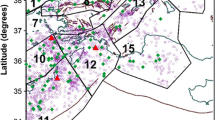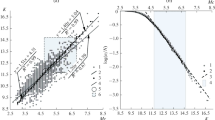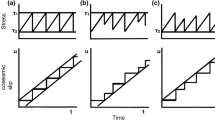Abstract
The occurrence time of earthquakes can be anticipated or delayed by external phenomena that induce strain energy changes on the faults. ‘Anticipated’ earthquakes are generally called ‘triggered’; however, it can be controversial to label a specific earthquake as such, mostly because of the stochastic nature of earthquake occurrence and of the large uncertainties usually associated to stress modelling. Here we introduce a combined statistical and physical approach to quantify the probability that a given earthquake was triggered by a given stress-inducing phenomenon. As an example, we consider an earthquake that was likely triggered by a natural event: the M = 6.2 13 Jan 1976 Kópasker earthquake on the Grímsey lineament (Tjörnes Fracture Zone, Iceland), which occurred about 3 weeks after a large dike injection in the nearby Krafla fissure swarm. By using Coulomb stress calculations and the rate-and-state earthquake nucleation theory, we calculate the likelihood of the earthquake in a scenario that contains only the tectonic background and excludes the dike and in a scenario that includes the dike but excludes the background. Applying the Bayes’ theorem, we obtain that the probability that the earthquake was indeed triggered by the dike, rather than purely due to the accumulation of tectonic strain, is about 60 to 90 %. This methodology allows us to assign quantitative probabilities to different scenarios and can help in classifying earthquakes as triggered or not triggered by natural or human-induced changes of stress in the crust.













Similar content being viewed by others
References
Bender B (1983) Maximum likelihood estimation of b values for magnitude grouped data. Bull Seismol Soc Am 73:831–851
Björnsson A (1985) Dynamics of crustal rifting in NE Iceland. J Geophys Res 90 (B12):10.151–10.162
Buck W, Einarsson P, Brandsdóttir B (2006) Tectonics stress and magma chamber size as controls on dike propagation: constraints from the 1975–1984 Krafla rifting episode. J Geophys Res 111:B12,404. doi:10.1029/2005JB003879
Cayol V, Dieterich J, Okamura A, Miklius A (2000) High magma storage rates before the 1983 eruption of Kilauea, Hawaii. Science 288(5475):2343–2346. doi:10.1126/science.288.5475.2343
Cesca S, Rohr A, Dahm T (2011) Discrimination of induced seismicity by full moment tensor inversion and decomposition. J Seismol, this issue
Cocco M, Hainzl S, Catalli F, Enescu B, Lombardi A, Woessner J (2010) Sensitivity study of forecasted aftershock seismicity based on Coulomb stress calculation and rate- and state-dependent frictional response. J Geophys Res 115:B05,307. doi:10.1029/2009JB006838
Dahm T (2000) Numerical simulations of the propagation path and the arrest of fluid-filled fractures in the Earth. Geophys J Int 141:623–638
Dieterich J (1994) A constitutive law for rate of earthquake production and its application to earthquake clustering. J Geophys Res 99(B2):2601–2618
Dieterich J, Kilgore B (1996) Implications of fault constitutive properties for earthquake prediction. Proc Natl Acad Sci U S A 93:3787–3794
Dieterich J, Cayol V, Okubo P (2000) The use of earthquake rate changes as a stress meter at Kilauea Volcano. Nature 408:457–460
Einarsson P (1987) Compilation of fault plane solutions in the North Atlantic and Artict Oceans. In: Kasahara K (ed) Recent plate movements and deformation, geodyn. ser., vol 20. AGU, Washington, DC, pp 47–62
Einarsson P, Brandsdóttir B (1980) Seismological evidence for lateral magma intrusion during the July 1978 deflation of the Krafla volcano in NE Iceland. J Geophys 47:160–165
Feuillet N, Cocco M, Musumeci C, Nostro C (2006) Stress interaction between seismic and volcanic activity at Mt Etna. Geophys J Int 164:697–718. doi:10.1111/j.1365-246X.2005.02824.x
Geirsson H, Arnadottir T, Volksen C, Jiang W, Sturkell E, Villemin T, Einarsson P, Sigmundsson F, Stefansson R (2006) Current plate movements across the Mid-Atlantic Ridge determined from 5 years of continuous GPS measurements in Iceland. J Geophys Res 111:B09,407. doi:10.1029/2005JB003717
Hainzl S, Steacy S, Marsan D (2010) Seismicity models based on Coulomb stress calculations. Community online resource for statistical seismicity analysis (CORSSA). doi:10.5078/corssa-32035809. http://www.corssa.org
Halldórson P (2005) Jardskjálftavirkni á Nordurlandi, Icelandic Meteorological Office. Report 05021-VÍ-ES-10. http://www.vedur.is/utgafa/greinargerdir/2005
Harris RA (1998) Introduction to special section: stress triggers, stress shadows, and implications for seismic hazard. J Geophys Res 103(24):347–24
Hensch M, Riedel C, Reinhardt J, T D (2008) Hypocenter migration of fluid-induced earthquake swarms in the Tjörnes Fracture Zone (North Iceland). Tectonophysics 447(1-4):80–94
Hill DP (1977) A model for earthquake swarms. J Geophys Res 82(8):1347–1352. doi:10.1029/JB082i008p01347
Hill DP, Pollitz F, Newhall C (2002) Earthquake–volcano interactions. Phys Today 55:41–47. doi:10.1063/1.1535006
Jacques E, King G, Tapponnier P, Ruegg J, Manighetti I (1996) Seismic triggering by stress change after the 1978 events in the Asal Rift, Djibouti. Geophys Res Lett 23(18):2481–2484
Jónsson S, Segall P, Pedersen R, Björnsson G (2003) Post-earthquake ground movements correlated to pore-pressure transients. Nature 424(6945):179–183. doi:10.1038/nature01776
King GCP, Cocco M (2000) Fault interaction by elastic stress changes: new clues from earthquake sequences. Adv Geophys 44:1–36
Lengliné O, Marsan D, Got JL, Pinel V, Ferrazzini V, Okubo PG (2008) Seismicity and deformation induced by magma accumulation at three basaltic volcanoes. J Geophys Res 113:B12,305. doi:10.1029/2008JB005937
Maccaferri F, Bonafede M, Rivalta E (2010) A numerical model of dyke propagation in layered elastic media. Geophys J Int 180:1107–1123
Metzger S, Jónsson S, Geirsson H (2011) Locking depth and slip-rate of the Húsavík Flatey fault, North Iceland, derived from continuous GPS data 2006–2010. Geophys J Int 187(2):564–576. doi:10.1111/j.1365-246X.2011.05176.x
Ogata Y (1983) Estimation of the parameters in the modified Omori formula for aftershock frequencies by the maximum likelihood procedure. J Phys Earth 31:115–124
Parsons T (2002) Global Omori law decay of triggered earthquakes: large aftershocks outside the classical aftershock zone. J Geophys Res 107:B9, 2199
Riedel C, Petersen T, Theilen F, Neben S (2003) High b-value in the leaky segment of the Tjörnes fracture zone north of Iceland: are they evidence for shallow magmatic sources? J Volcanol Geotherm Res 128:15–29. doi:10.1016/S0377-0273(03)00244-0
Riedel C, Tryggvason A, Dahm T, Stefanson R, Bodvarson R, Gudmundsson G (2005) The seismic velocity structure north of Iceland from joint inversion of local earthquakes data. J Seismol 9:383–404
Rivalta E, Dahm T (2004) Dyke emplacement in fractured media: application to the 2000 intrusion at Izu islands, Japan. Geophys J Int 157:283–292
Rögnvaldsson ST, Gudmundsson A, Slunga R (1998) Seismotectonic analysis of the Tjörnes fracture zone, an active transform fault in north Iceland. J Geophys Res 103(B12):30,117–30,129
Segall P, Desmarais E, Shelly D, Miklius A, Cervelli P (2006) Earthquake triggered by silent slip events on Kilauea Volcano, Hawaii. Nature 442:71–74. doi:10.1038/nature04938
Shi Y, Bolt B (1982) The standard error of the magnitude-frequency b value. Bull Seismol Soc Am 72(5):1677–1687
Stefansson R, Gudmundsson G, Halldorsson P (2008) Tjörnes fracture zone. New and old seismic evidences for the link between the North Iceland rift zone and the Mid-Atlantic ridge. Tectonophysics 447:117–126
Stein RS (1999) The role of stress transfer in earthquake occurrence. Nature 402:605–609
Toda S, Stein R (2003) Toggling seismicity by the 1997 Kagoshima earthquake couplet: a demonstration of time-dependent stress transfer. J Geophys Res 108:B122,567. doi:10.1029/2003JB002557
Toda S, Stein R, Sagiya T (2002) Evidence from the AD 2000 Izu islands earthquake swarm that stressing rate governs seismicity. Nature 419:58–61
Tryggvason E (1984) Widening of the Krafla fissure swarm during the 1975–1981 volcano-tectonic episode. Bull Volcanol 47(1):47–69
Utsu T, Ogata Y, Matsu’ura S (1995) The centenary of the Omori formula for a decay law of aftershock activity. J Phys Earth 43:1–33
Wessel P, Smith WHF (1998) New, improved version of the generic mapping tools released. EOS Trans AGU 79:579
Wiemer S, Wyss M (2000) Minimum magnitude of completeness in earthquake catalogs: examples from Alaska, the Western United States, and Japan. Bull Seismol Soc Am 90:859–869
Author information
Authors and Affiliations
Corresponding author
Appendix: Rate-and-state earthquake nucleation model
Appendix: Rate-and-state earthquake nucleation model
The rate-and-state earthquake nucleation model relates earthquake production per unit area on a population of faults to the evolution of a state variable, γ:
where N is the number of events per unit area in the time interval [0, T]. For a constant shear stressing rate, γ is equal to \(\gamma_0 = 1/\dot\tau\), which yields R = r (steady state): The seismicity rate remains at its constant background value until an external stress perturbation intervenes. The state variable γ evolves with time as:
where A is a constitutive parameter, σ is the effective normal stress and dS = ΔCFF is the Coulomb stress change (Eq. 8). Step-like stress perturbations are accounted for by setting dt = 0 in Eq. 19 and integrating:
where γ 1 and γ 0 are the state variable values before and after the stress perturbation, respectively. By substituting Eqs. 20 in 18 and eliminating the variable γ, the peak in seismicity rate right after the stress change is obtained explicitly:
After a step-like stress change, the tectonic stressing rate dominates in controlling the seismicity rate, which experiences a transient until it reaches again steady state. Setting \({\rm d}S=\dot\tau\,{\rm d}t\) Eq. 19 and integrating:
which implies that the time needed for R to return to steady state is inversely proportional to \(\dot\tau\). The state variable γ can be eliminated by combining Eqs. 18, 20 and 22:
The expected number of events for a given region in a time window Δt = t 2 − t 1 can be calculated by integrating the seismicity rate over the time interval:
Rights and permissions
About this article
Cite this article
Passarelli, L., Maccaferri, F., Rivalta, E. et al. A probabilistic approach for the classification of earthquakes as ‘triggered’ or ‘not triggered’. J Seismol 17, 165–187 (2013). https://doi.org/10.1007/s10950-012-9289-4
Received:
Accepted:
Published:
Issue Date:
DOI: https://doi.org/10.1007/s10950-012-9289-4




